spare tire MITSUBISHI OUTLANDER 2020 Owner's Manual (in English)
[x] Cancel search | Manufacturer: MITSUBISHI, Model Year: 2020, Model line: OUTLANDER, Model: MITSUBISHI OUTLANDER 2020Pages: 443, PDF Size: 60.03 MB
Page 12 of 443
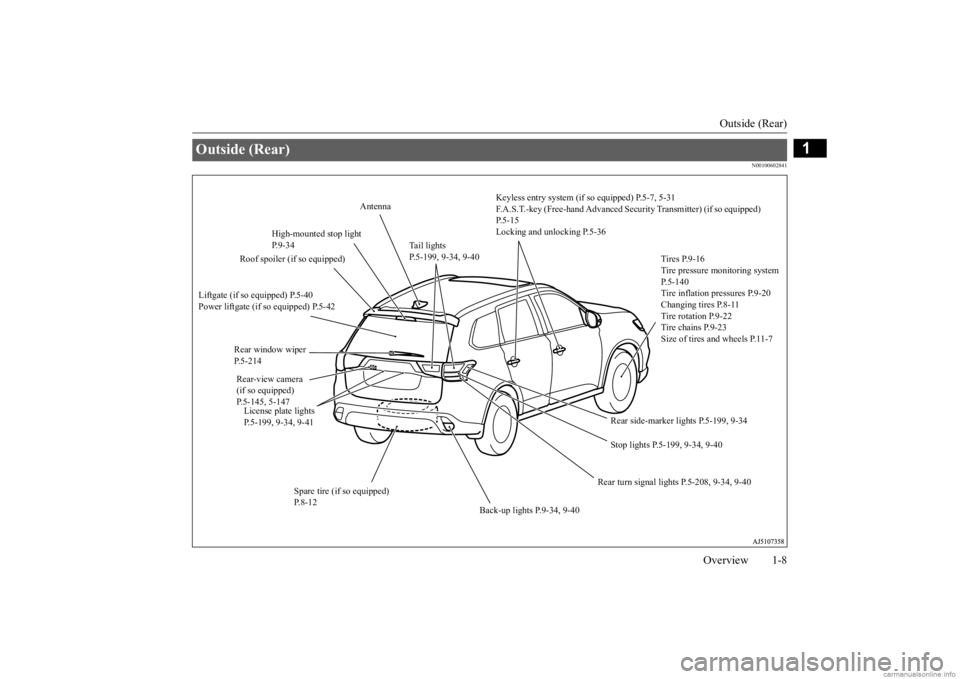
Outside (Rear)
Overview 1-8
1
N00100602841
Outside (Rear)
Keyless entry system (if so equipped) P.5-7, 5-31 F.A.S.T.-key (Free-hand Advanced Se
curity Transmitter) (if so equipped)
P.5-15 Locking and unlocking P.5-36
Tires P.9-16 Tire pressure monitoring system P.5-140Tire inflation pressures P.9-20Changing tires P.8-11 Tire rotation P.9-22 Tire chains P.9-23Size of tires and wheels P.11-7
Stop lights P.5-199, 9-34, 9-40
Rear turn signal lights P.5-208, 9-34, 9-40
Spare tire (if so equipped) P.8-12
Back-up lights P.9-34, 9-40
License plate lights P.5-199, 9-34, 9-41 Rear-view camera (if so equipped) P.5-145, 5-147 Rear window wiper P.5-214
High-mounted stop light P.9-34
Antenna
Liftgate (if so equipped) P.5-40 Power liftgate (if so equipped) P.5-42
Rear side-marker lights P.5-199, 9-34
Tail lights P.5-199, 9-34, 9-40
Roof spoiler (if so equipped)
BK0278200US.book 8 ページ 2019年4月10日 水曜日 午前10時59分
Page 20 of 443
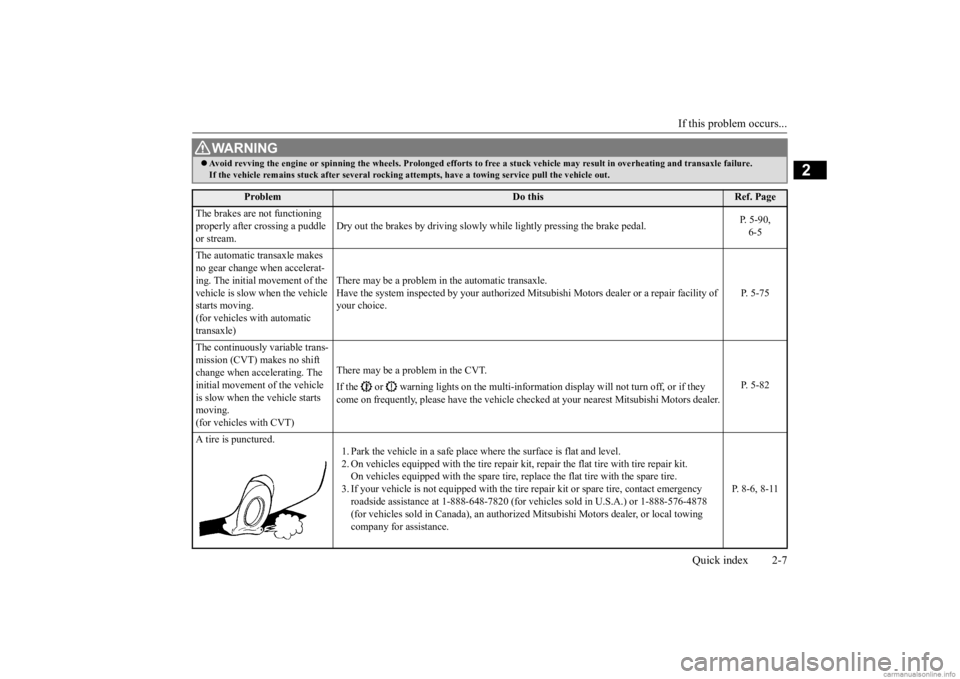
If this problem occurs...
Quick index 2-7
2
Avoid revving the engine or spin
ning the wheels. Prolonged efforts to free a st
uck vehicle may result in
overheating and transa
xle failure.
If the vehicle remains stuck after several rocking attempts, have a towing service pull the vehicle out.
Problem
Do this
Ref. Page
The brakes are not functioning properly after crossing a puddle or stream.
Dry out the brakes by driving slowly
while lightly pressing the brake pedal.
P. 5-90, 6-5
The automatic transaxle makes no gear change when accelerat- ing. The initial movement of the vehicle is slow
when the vehicle
starts moving. (for vehicles with automatic transaxle)
There may be a problem in the automatic transaxle. Have the system inspected by your authorized Mitsub
ishi Motors dealer or
a repair facility of
your choice.
P. 5-75
The continuously variable trans- mission (CVT) makes no shift change when accelerating. The initial movement of the vehicle is slow when the vehicle starts moving.(for vehicles with CVT)
There may be a problem in the CVT. If the or warning lights on the multi-informat
ion display will not turn off, or if they
come on frequently, please have the vehicle chec
ked at your nearest Mits
ubishi Motors dealer.
P. 5-82
A tire is punctured.
1. Park the vehicle in a safe place where the surface is flat and level. 2. On vehicles equipped with the
tire repair kit, repair the flat tire with tire repair kit.
On vehicles equipped with the spare tire, replace the flat tire with the spare tire. 3. If your vehicle is not equippe
d with the tire repair kit or
spare tire, contact emergency
roadside assistance at 1-888-648-7820 (for ve
hicles sold in U.S.A.) or 1-888-576-4878
(for vehicles sold in Canada),
an authorized Mitsubishi Mo
tors dealer, or local towing
company for assistance.
P. 8 - 6 , 8 - 1 1
WA R N I N G
BK0278200US.book 7 ページ 2019年4月10日 水曜日 午前10時59分
Page 183 of 443
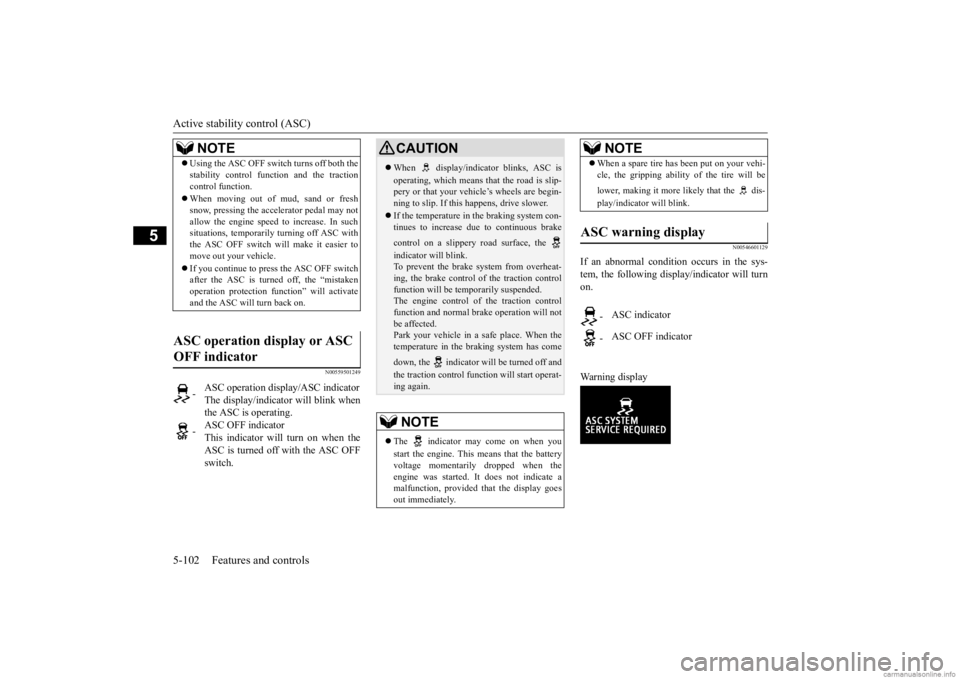
Active stability control (ASC) 5-102 Features and controls
5
N00559501249
N00546601129
If an abnormal condition occurs in the sys- tem, the following display/indicator will turn on. Warning display
NOTE
Using the ASC OFF switch turns off both the stability control function and the tractioncontrol function. When moving out of mud, sand or fresh snow, pressing the accelerator pedal may notallow the engine speed to increase. In such situations, temporarily turning off ASC with the ASC OFF switch will make it easier tomove out your vehicle. If you continue to press the ASC OFF switch after the ASC is turned off, the “mistaken operation protection f
unction” will activate
and the ASC will turn back on.
ASC operation display or ASC OFF indicator
-
ASC operation display/ASC indicator The display/indicator will blink when the ASC is operating.
-
ASC OFF indicator This indicator will turn on when the ASC is turned off with the ASC OFFswitch.
CAUTION When display/indi
cator blinks, ASC is
operating, which means th
at the road is slip-
pery or that your vehi
cle’s wheels are begin-
ning to slip. If this happens, drive slower. If the temperature in the braking system con- tinues to increase due
to continuous brake
control on a slippery road surface, the indicator will blink. To prevent the brake system from overheat-ing, the brake control of the traction control function will be te
mporarily suspended.
The engine control of
the traction control
function and normal br
ake operation will not
be affected. Park your vehicle in a safe place. When thetemperature in the braking system has come down, the indicator will be turned off and the traction control function will start operat- ing again.NOTE
The indicator may come on when you start the engine. This means that the battery voltage momentarily dropped when theengine was started. It
does not indicate a
malfunction, provided th
at the display goes
out immediately.
When a spare tire has been put on your vehi- cle, the gripping ability of the tire will be lower, making it more
likely that the dis-
play/indicator will blink.
ASC warning display
-
ASC indicator
-
ASC OFF indicatorNOTE
BK0278200US.book 102 ページ 2019年4月10日 水曜日 午前10時59分
Page 194 of 443
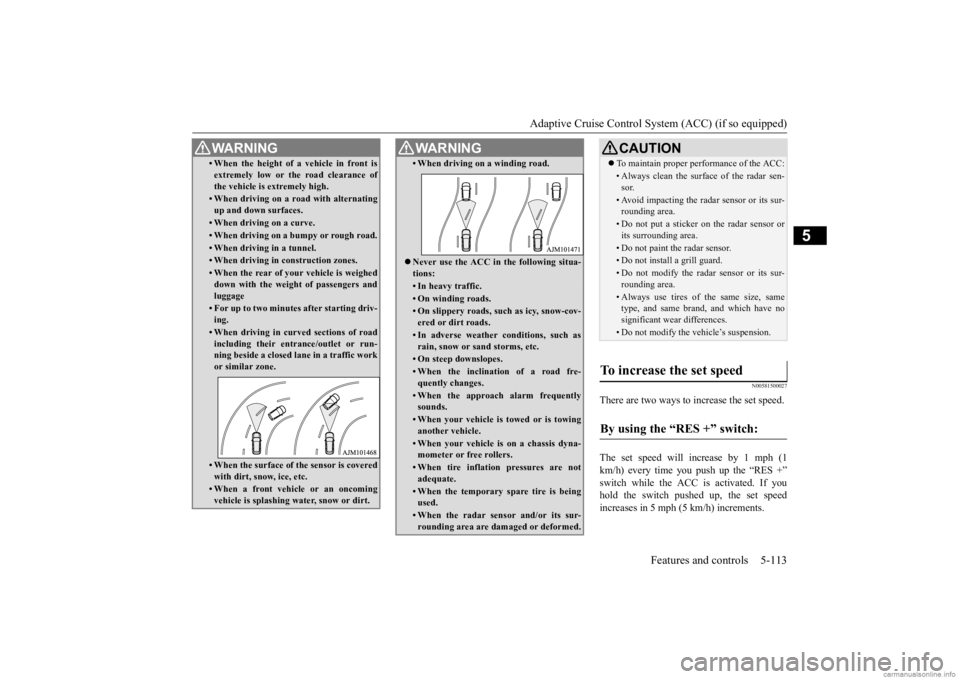
Adaptive Cruise Control System (ACC) (if so equipped)
Features and controls 5-113
5
N00581500027
There are two ways to increase the set speed. The set speed will increase by 1 mph (1 km/h) every time you push up the “RES +” switch while the ACC is activated. If youhold the switch pushed up, the set speed increases in 5 mph (5 km/h) increments.
• When the height of a vehicle in front is extremely low or the road clearance ofthe vehicle is extremely high.• When driving on a r
oad with alternating
up and down surfaces.• When driving on a curve.• When driving on a bumpy or rough road.• When driving in a tunnel.• When driving in construction zones.• When the rear of your vehicle is weighed down with the weight of passengers and luggage• For up to two minute
s after starting driv-
ing.• When driving in curved sections of roadincluding their entrance/outlet or run-ning beside a closed lane in a traffic work or similar zone.• When the surface of the sensor is covered with dirt, snow, ice, etc.• When a front vehicl
e or an oncoming
vehicle is splashing wa
ter, snow or dirt.
WA R N I N G
• When driving on
a winding road.
Never use the ACC in the following situa- tions:• In heavy traffic.• On winding roads.• On slippery roads, su
ch as icy, snow-cov-
ered or dirt roads.• In adverse weather
conditions, such as
rain, snow or sand storms, etc.• On steep downslopes.• When the inclination of a road fre-quently changes.• When the approach alarm frequentlysounds.• When your vehicle is towed or is towinganother vehicle.• When your vehicle is on a chassis dyna-mometer or free rollers.• When tire inflation pressures are notadequate.• When the temporary spare tire is beingused.• When the radar sensor and/or its sur-rounding area are damaged or deformed.WA R N I N G
CAUTION To maintain proper performance of the ACC:• Always clean the surface of the radar sen- sor.• Avoid impacting the radar sensor or its sur-rounding area.• Do not put a sticker on the radar sensor orits surrounding area.• Do not paint the radar sensor.• Do not install a grill guard.• Do not modify the radar sensor or its sur- rounding area.• Always use tires of the same size, sametype, and same brand,
and which have no
significant wear differences.• Do not modify the vehicle’s suspension.
To increase the set speed
By using the “RES +” switch:
BK0278200US.book 113 ページ 2019年4月10日 水曜日 午前10時59分
Page 203 of 443
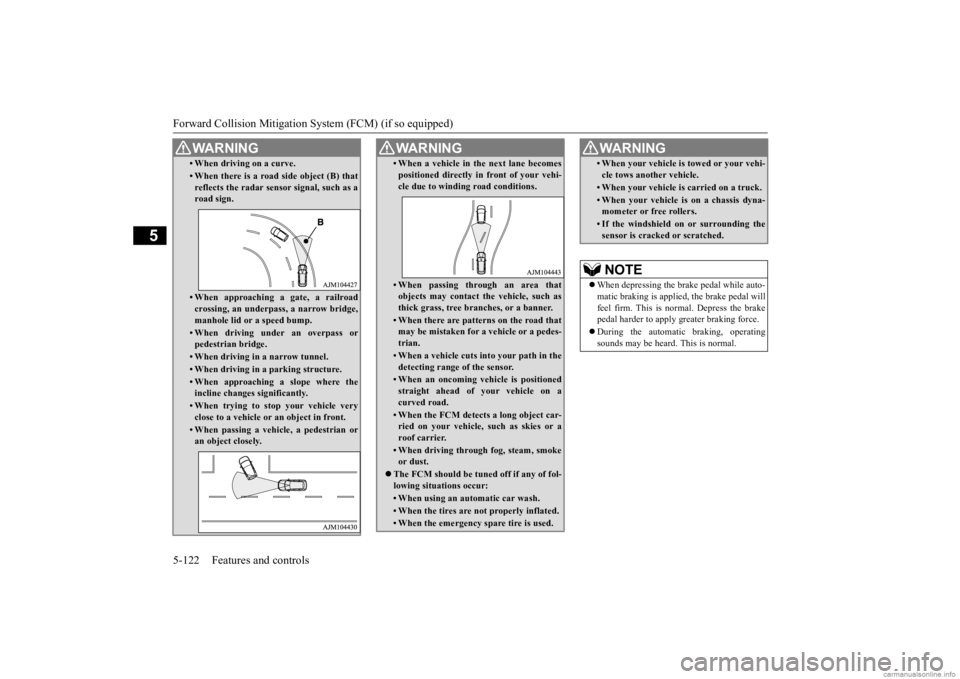
Forward Collision Mitigation System (FCM) (if so equipped) 5-122 Features and controls
5
• When driving on a curve.• When there is a road side object (B) that reflects the radar sensor signal, such as a road sign.• When approaching
a gate, a railroad
crossing, an underpas
s, a narrow bridge,
manhole lid or
a speed bump.
• When driving under an overpass or pedestrian bridge.• When driving in a narrow tunnel.• When driving in a parking structure.• When approaching a slope where the incline changes
significantly.
• When trying to st
op your vehicle very
close to a vehicle or
an object in front.
• When passing a vehicle, a pedestrian or an object closely.WA R N I N G
• When a vehicle in the next lane becomespositioned directly in
front of your vehi-
cle due to winding road conditions.• When passing through an area that objects may contact the vehicle, such as thick grass, tree branches, or a banner.• When there are patterns on the road thatmay be mistaken for a vehicle or a pedes-trian.• When a vehicle cuts into your path in thedetecting range of the sensor.• When an oncoming ve
hicle is positioned
straight ahead of your vehicle on a curved road.• When the FCM detects a long object car-ried on your vehicle,
such as skies or a
roof carrier.• When driving through fog, steam, smokeor dust.
The FCM should be tune
d off if any of fol-
lowing situations occur:• When using an automatic car wash.• When the tires are not properly inflated. • When the emergency spare tire is used.WA R N I N G
• When your vehicle is
towed or your vehi-
cle tows another vehicle.• When your vehicle is carried on a truck.• When your vehicle is on a chassis dyna-mometer or free rollers.•If the windshield on
or surrounding the
sensor is cracke
d or scratched.
NOTE
When depressing the brake pedal while auto- matic braking is applied, the brake pedal will feel firm. This is normal. Depress the brake pedal harder to apply
greater braking force.
During the automatic
braking, operating
sounds may be heard. This is normal. WA R N I N G
BK0278200US.book 122 ページ 2019年4月10日 水曜日 午前10時59分
Page 221 of 443
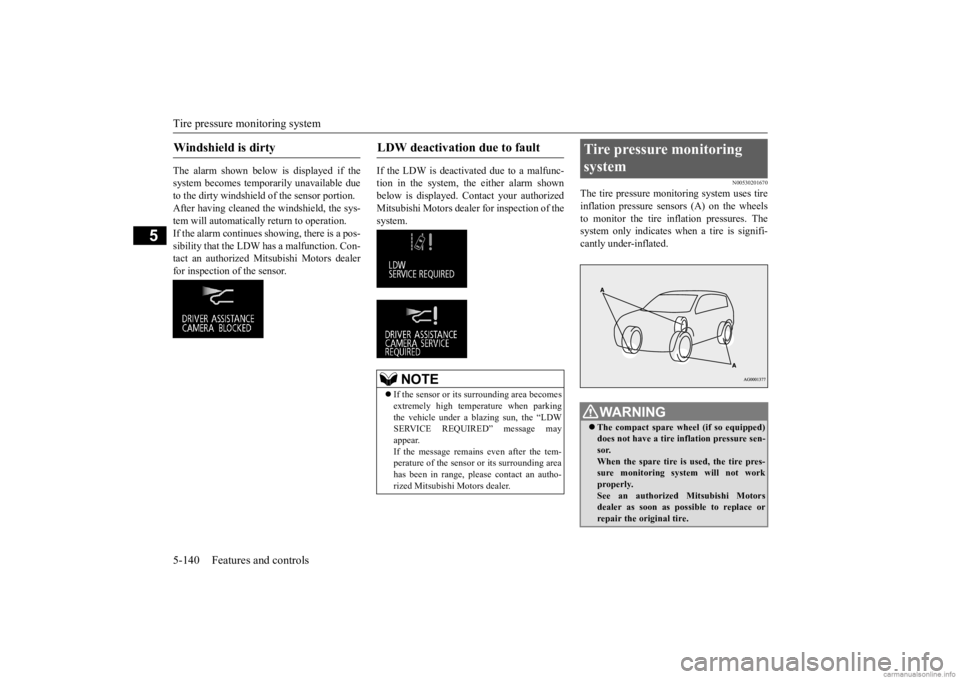
Tire pressure monitoring system 5-140 Features and controls
5
The alarm shown below is displayed if the system becomes temporarily unavailable due to the dirty windshield of the sensor portion. After having cleaned the windshield, the sys-tem will automatically return to operation. If the alarm continues s
howing, there is a pos-
sibility that the LDW
has a malfunction. Con-
tact an authorized Mitsubishi Motors dealer for inspection of the sensor.
If the LDW is deactiva
ted due to a malfunc-
tion in the system, the either alarm shown below is displayed.
Contact your authorized
Mitsubishi Motors dealer for inspection of thesystem.
N00530201670
The tire pressure moni
toring system uses tire
inflation pressure sensors (A) on the wheels to monitor the tire inflation pressures. Thesystem only indicates wh
en a tire is signifi-
cantly under-inflated.
Windshield is dirty
LDW deactivation due to fault
NOTE
If the sensor or its surrounding area becomes extremely high temperature when parking the vehicle under a bl
azing sun, the “LDW
SERVICE REQUIRED” message may appear. If the message remains even after the tem-perature of the sensor or its surrounding area has been in range, plea
se contact an autho-
rized Mitsubishi Motors dealer.
Tire pressure monitoring system
WA R N I N G The compact spare wheel (if so equipped) does not have a tire inflation pressure sen-sor. When the spare tire is used, the tire pres- sure monitoring system will not workproperly. See an authorized
Mitsubishi Motors
dealer as soon as po
ssible to replace or
repair the original tire.
BK0278200US.book 140 ページ 2019年4月10日 水曜日 午前10時59分
Page 222 of 443
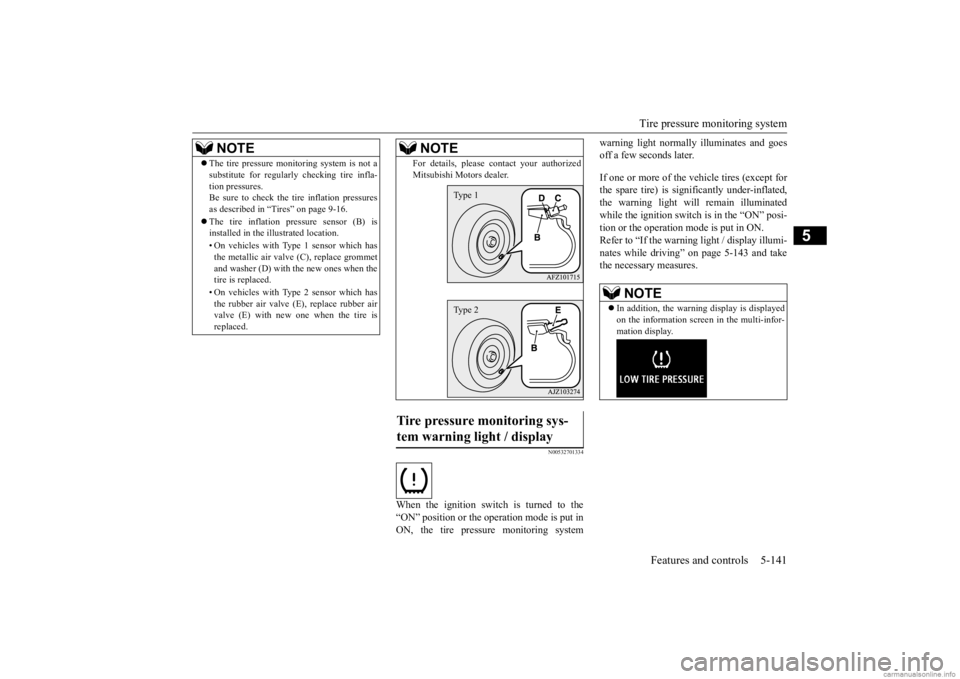
Tire pressure monitoring system
Features and controls 5-141
5
N00532701334
When the ignition switch is turned to the “ON” position or the ope
ration mode is put in
ON, the tire pressure monitoring system
warning light normally
illuminates and goes
off a few seconds later. If one or more of the vehicle tires (except for the spare tire) is significantly under-inflated, the warning light will remain illuminated while the ignition switch is in the “ON” posi-tion or the operation mode is put in ON. Refer to “If the warning light / display illumi- nates while driving” on
page 5-143 and take
the necessary measures.
NOTE
The tire pressure monitoring system is not a substitute for regularly
checking tire infla-
tion pressures.Be sure to check the tire inflation pressures as described in “Tires” on page 9-16. The tire inflation pressure sensor (B) is installed in the illustrated location. • On vehicles with Type
1 sensor which has
the metallic air valve (C), replace grommet and washer (D) with the new ones when thetire is replaced. • On vehicles with Type
2 sensor which has
the rubber air valve (E), replace rubber air valve (E) with new one when the tire is replaced.
For details, please
contact your authorized
Mitsubishi Moto
rs dealer.
Tire pressure monitoring sys- tem warning light / display
NOTE
Type 1Type 2
NOTE
In addition, the warni
ng display is displayed
on the information screen in the multi-infor-mation display.
BK0278200US.book 141 ページ 2019年4月10日 水曜日 午前10時59分
Page 223 of 443
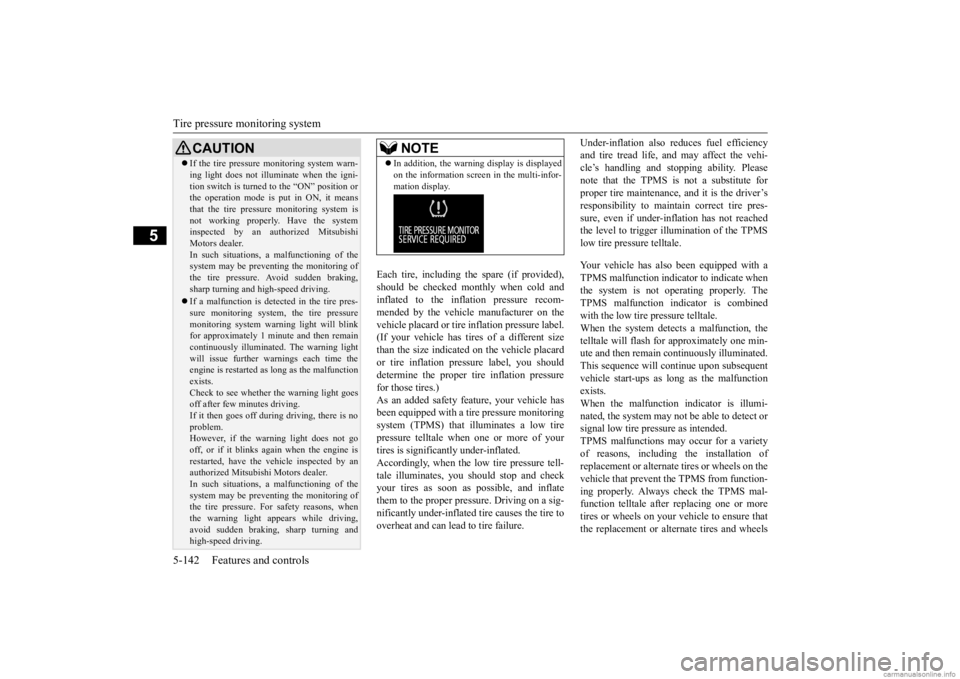
Tire pressure monitoring system 5-142 Features and controls
5
Each tire, including the spare (if provided), should be checked monthly when cold and inflated to the inflation pressure recom-mended by the vehicle manufacturer on the vehicle placard or tire in
flation pressure label.
(If your vehicle has tires of a different sizethan the size indicated on the vehicle placard or tire inflation pres
sure label, you should
determine the proper ti
re inflation pressure
for those tires.) As an added safety fe
ature, your vehicle has
been equipped with a ti
re pressure monitoring
system (TPMS) that illuminates a low tire pressure telltale when one or more of your tires is significan
tly under-inflated.
Accordingly, when the low tire pressure tell- tale illuminates, you should stop and check your tires as soon as
possible, and inflate
them to the proper pressure. Driving on a sig- nificantly under-inflated
tire causes the tire to
overheat and can lead to tire failure.
Under-inflation also reduces fuel efficiency and tire tread life, a
nd may affect the vehi-
cle’s handling and stopping ability. Please note that the TPMS is not a substitute for proper tire maintenance, and it is the driver’sresponsibility to mainta
in correct tire pres-
sure, even if under-inf
lation has not reached
the level to trigger illumination of the TPMSlow tire pressure telltale. Your vehicle has also been equipped with a TPMS malfunction indica
tor to indicate when
the system is not operating properly. The TPMS malfunction indicator is combined with the low tire pressure telltale.When the system detects a malfunction, the telltale will flash for approximately one min- ute and then remain continuously illuminated.This sequence will continue upon subsequent vehicle start-ups as
long as the malfunction
exists.When the malfunction indicator is illumi- nated, the system may not
be able to detect or
signal low tire pressure as intended.TPMS malfunctions may
occur for a variety
of reasons, including the installation of replacement or alternate tires or wheels on thevehicle that prevent the TPMS from function- ing properly. Always check the TPMS mal- function telltale after
replacing one or more
tires or wheels on your vehicle to ensure that the replacement or alternate tires and wheels
CAUTION If the tire pressure monitoring system warn- ing light does not illumi
nate when the igni-
tion switch is turned to the “ON” position orthe operation mode is put in ON, it means that the tire pressure monitoring system is not working properly. Have the systeminspected by an authorized Mitsubishi Motors dealer. In such situations,
a malfunctioning of the
system may be preventing the monitoring of the tire pressure. Avoid sudden braking, sharp turning and high-speed driving. If a malfunction is detected in the tire pres- sure monitoring system, the tire pressuremonitoring system warn
ing light will blink
for approximately 1 minute and then remain continuously illuminated. The warning lightwill issue further warnings each time the engine is restarted as
long as the malfunction
exists.Check to see whether
the warning light goes
off after few minutes driving. If it then goes off during driving, there is noproblem. However, if the warning light does not go off, or if it blinks again when the engine isrestarted, have the vehicle inspected by an authorized Mitsubishi Motors dealer. In such situations,
a malfunctioning of the
system may be preventing the monitoring of the tire pressure. For safety reasons, when the warning light appears while driving,avoid sudden braking, sharp turning and high-speed driving.
NOTE
In addition, the warni
ng display is displayed
on the information screen in the multi-infor-mation display.
BK0278200US.book 142 ページ 2019年4月10日 水曜日 午前10時59分
Page 224 of 443
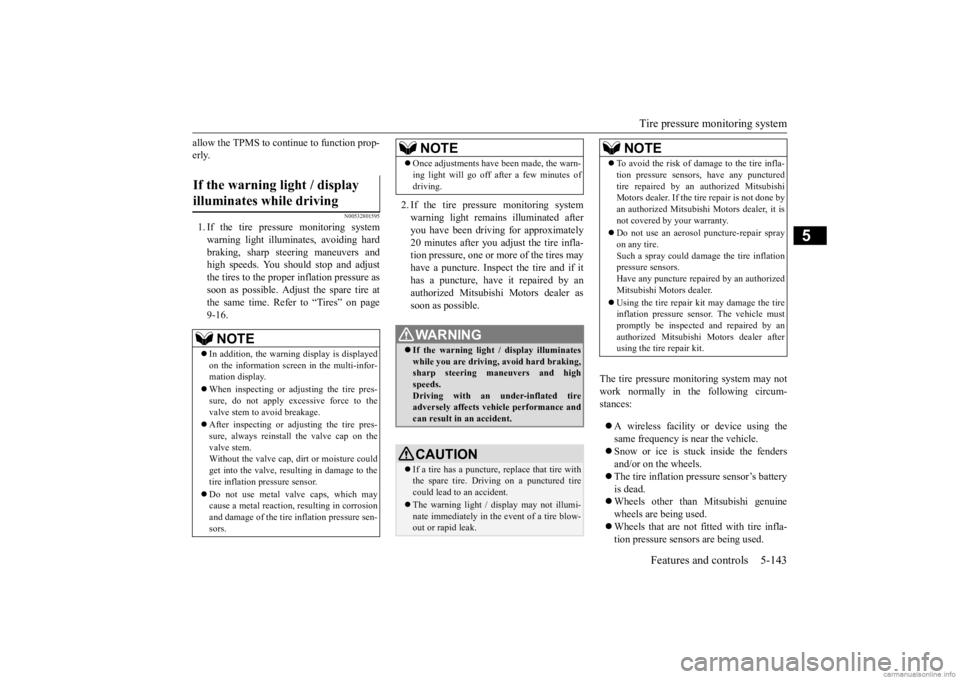
Tire pressure monitoring system
Features and controls 5-143
5
allow the TPMS to continue to function prop- erly.
N00532801595
1. If the tire pressure monitoring systemwarning light illumi
nates, avoiding hard
braking, sharp steering maneuvers and high speeds. You should stop and adjust the tires to the proper inflation pressure as soon as possible. Adjust the spare tire atthe same time. Refer to “Tires” on page 9-16.
2. If the tire pressure monitoring system warning light remains illuminated afteryou have been driving for approximately 20 minutes after you adjust the tire infla- tion pressure, one or more of the tires mayhave a puncture. Inspect the tire and if it has a puncture, have it repaired by an authorized Mitsubishi Motors dealer assoon as possible.
The tire pressure monitoring system may not work normally in the following circum- stances: A wireless facility or device using the same frequency is near the vehicle. Snow or ice is stuck inside the fenders and/or on the wheels. The tire inflation pres
sure sensor’s battery
is dead. Wheels other than Mitsubishi genuine wheels are being used. Wheels that are not fitted with tire infla- tion pressure sensors are being used.
If the warning light / display illuminates while driving
NOTE
In addition, the warni
ng display is displayed
on the information screen in the multi-infor- mation display. When inspecting or adjusting the tire pres- sure, do not apply excessive force to the valve stem to avoid breakage. After inspecting or adju
sting the tire pres-
sure, always reinstall the valve cap on thevalve stem. Without the valve cap, dirt or moisture could get into the valve, resulting in damage to thetire inflation pressure sensor. Do not use metal valve caps, which may cause a metal reaction, resulting in corrosion and damage of the tire inflation pressure sen- sors.
Once adjustments have
been made, the warn-
ing light will go off after a few minutes ofdriving.WA R N I N G If the warning light / display illuminates while you are driving,
avoid hard braking,
sharp steering maneuvers and high speeds.Driving with an under-inflated tire adversely affects vehicle performance and can result in an accident.CAUTION If a tire has a puncture,
replace that tire with
the spare tire. Driving on a punctured tirecould lead to an accident. The warning light / di
splay may not illumi-
nate immediately in the
event of a tire blow-
out or rapid leak.NOTE
NOTE
To avoid the risk of da
mage to the tire infla-
tion pressure sensors, have any puncturedtire repaired by an authorized MitsubishiMotors dealer. If the tir
e repair is not done by
an authorized Mitsubishi Motors dealer, it is not covered by your warranty. Do not use an aerosol puncture-repair spray on any tire.Such a spray could damage the tire inflation pressure sensors. Have any puncture repaired by an authorizedMitsubishi Motors dealer. Using the tire repair kit may damage the tire inflation pressure sensor. The vehicle must promptly be inspected and repaired by an authorized Mitsubishi Motors dealer afterusing the tire repair kit.
BK0278200US.book 143 ページ 2019年4月10日 水曜日 午前10時59分
Page 225 of 443
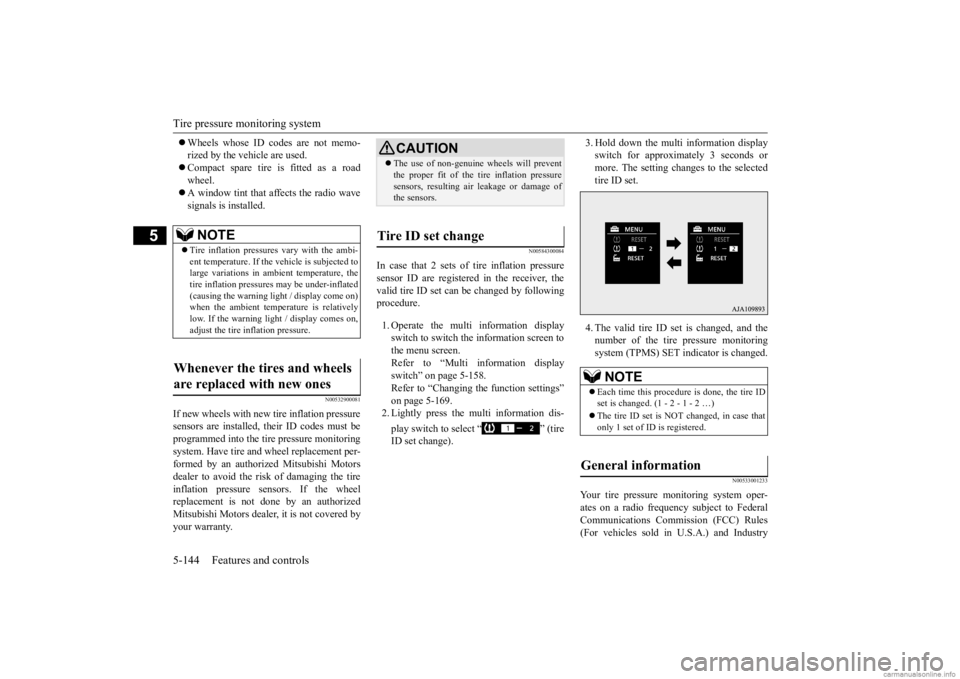
Tire pressure monitoring system 5-144 Features and controls
5
Wheels whose ID codes are not memo- rized by the vehicle are used. Compact spare tire is fitted as a road wheel. A window tint that affects the radio wave signals is installed.
N00532900081
If new wheels with new tire inflation pressuresensors are installed, their ID codes must beprogrammed into the tire pressure monitoring system. Have tire and wheel replacement per- formed by an authorized Mitsubishi Motorsdealer to avoid the ri
sk of damaging the tire
inflation pressure sensors. If the wheel replacement is not done by an authorizedMitsubishi Motors dealer
, it is not covered by
your warranty.
N00584300084
In case that 2 sets of
tire inflation pressure
sensor ID are registered in the receiver, the valid tire ID set can be
changed by following
procedure. 1. Operate the multi information display switch to switch the information screen to the menu screen. Refer to “Multi information displayswitch” on page 5-158. Refer to “Changing th
e function settings”
on page 5-169.2. Lightly press the multi information dis- play switch to select “ ” (tire ID set change).
3. Hold down the multi information display switch for approxima
tely 3 seconds or
more. The setting changes to the selected tire ID set. 4. The valid tire ID set is changed, and the number of the tire
pressure monitoring
system (TPMS) SET i
ndicator is changed.
N00533001233
Your tire pressure monitoring system oper- ates on a radio frequenc
y subject to Federal
Communications Commission (FCC) Rules (For vehicles sold in U.S.A.) and Industry
NOTE
Tire inflation pressures vary with the ambi- ent temperature. If the
vehicle is subjected to
large variations in am
bient temperature, the
tire inflation pressures may be under-inflated (causing the warning li
ght / display come on)
when the ambient temperature is relatively low. If the warning light / display comes on, adjust the tire inflation pressure.
Whenever the tires and wheels are replaced with new ones
CAUTION The use of non-genuine wheels will prevent the proper fit of the tire inflation pressuresensors, resulting air
leakage or damage of
the sensors.
Tire ID set change
NOTE
Each time this procedure is done, the tire ID set is changed. (1 - 2 - 1 - 2 …) The tire ID set is NOT changed, in case that only 1 set of ID is registered.
General information
BK0278200US.book 144 ページ 2019年4月10日 水曜日 午前10時59分